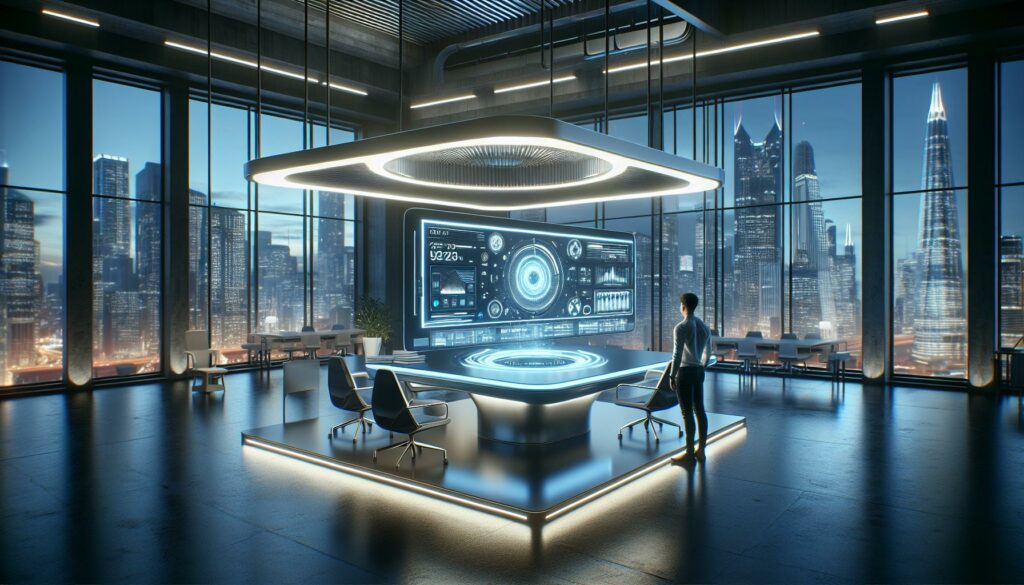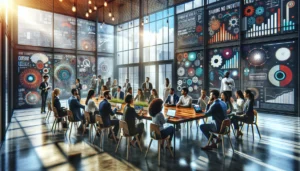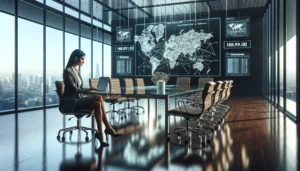
“
I’ve always been fascinated by how hi-tech design shapes our world. From sleek smartphones to cutting-edge smart homes technology continues to redefine aesthetics and functionality in ways we never imagined. Modern design isn’t just about looking futuristic – it’s about creating seamless experiences that enhance our daily lives.
As a tech enthusiast and designer I’ve witnessed the evolution of hi-tech design firsthand. It’s incredible to see how elements like minimalism smart materials and interactive interfaces have become fundamental parts of contemporary design language. What’s even more exciting is how artificial intelligence and machine learning are pushing the boundaries of what’s possible in design innovation.
Key Takeaways
Hi-tech design combines minimalist aesthetics with advanced technologies, emphasizing clean lines, smart materials, and seamless integration of digital interfaces
Key elements include electrochromic glass, carbon fiber composites, smart fabrics, and interactive features like motion-activated lighting and touch-sensitive surfaces
Modern hi-tech aesthetics have evolved from retro-futuristic chrome finishes to contemporary minimalism with understated elegance and natural materials
Sustainable approaches in hi-tech design integrate AI-powered systems, smart resource management, and eco-friendly materials to reduce environmental impact
Advanced manufacturing techniques like 3D printing, laser sintering, and robotic fabrication enable the creation of sophisticated surfaces and complex forms
Integration of IoT sensors, AI algorithms, and machine learning capabilities allows for adaptive environments that respond to user preferences while maintaining aesthetic appeal
Hi Tech Design
Minimalist Aesthetics
Clean lines create visual sophistication in hi-tech design. I emphasize geometric shapes, monochromatic color schemes (black, white, silver) integrated lighting elements in my design approach. Smart spaces incorporate hidden technology features behind smooth surfaces creating an uncluttered environment.
Advanced Materials
Materials define modern hi-tech aesthetics:
- Electrochromic glass adjusts transparency based on electrical current
- Carbon fiber composites provide strength with minimal weight
- Self-healing polymers repair surface damage automatically
- Nano-coated surfaces repel water dirt stains
- Smart fabrics integrate sensors for environmental monitoring
Interactive Elements
Digital interfaces transform static designs into dynamic experiences:
- Motion-activated lighting responds to user movement
- Touch-sensitive surfaces control multiple functions
- Voice-controlled systems manage environmental settings
- Gesture recognition enables contactless operation
- Augmented reality displays overlay digital information
Smart Integration
Connected devices form cohesive systems:
- IoT sensors monitor environmental conditions
- AI algorithms optimize energy consumption
- Automated systems adjust to user preferences
- Cloud connectivity enables remote control
- Machine learning improves system performance
- Solar-powered charging systems
- Energy-efficient LED lighting arrays
- Recyclable composite materials
- Smart climate control systems
- Water conservation technologies
| Design Element | Technology Integration | User Benefit |
|---|---|---|
| Smart Materials | Sensors & Actuators | Adaptive Performance |
| Digital Interfaces | AI & ML Systems | Intuitive Control |
| Connected Systems | IoT Network | Seamless Operation |
| Eco Solutions | Green Tech | Resource Efficiency |
| Interactive Features | Motion & Touch Tech | Enhanced Experience |
The Evolution of Hi-Tech Design Aesthetics
Hi-tech design aesthetics have transformed from speculative visions to practical implementations through technological advancement. The progression reflects changes in both technological capabilities and cultural expectations of what future-forward design represents.
From Retro-Futurism to Modern Minimalism
Retro-futuristic design elements from the 1960s embraced chrome finishes metallic surfaces geometric patterns. Contemporary hi-tech aesthetics favor clean lines balanced proportions understated elegance. Key shifts include:
- Replaced bulky control panels with sleek touch interfaces
- Shifted from exposed mechanical components to seamless integration
- Evolved from sharp angles to subtle curves organic forms
- Transitioned from flashy metallic finishes to matte textures natural materials
- Incorporated gesture controls haptic feedback responsive surfaces
- Integrated ambient displays smart materials programmable lighting
- Added augmented reality layers digital overlays physical spaces
- Developed adaptive interfaces that respond to user behavior preferences
| Design Era | Key Materials | Interface Type | Color Palette |
|---|---|---|---|
| 1960s Retro | Chrome Steel | Physical Buttons | Metallic Silver |
| 1980s Tech | Plastic Glass | LCD Displays | Black White |
| Modern Era | Smart Materials | Touch Gesture | Neutral Earth Tones |
| Future Trend | Nano-materials | Brain-Computer | Adaptive Colors |
Materials and Finishes in Hi-Tech Design
Modern hi-tech design incorporates cutting-edge materials and advanced manufacturing techniques to create sophisticated surfaces and textures. These materials enhance both aesthetic appeal and functional performance in contemporary design applications.
Smart Materials and Surfaces
Smart materials transform hi-tech design through responsive properties and adaptive functionalities. Electrochromic glass changes transparency levels based on electrical current input, enabling dynamic privacy control in office spaces. Shape-memory alloys return to predetermined forms when heated, creating self-adjusting furniture pieces. Self-healing polymers automatically repair surface scratches through chemical reactions, extending product lifespans. Key applications include:
- Color-changing thermochromic surfaces for temperature indication
- Photochromic materials that respond to UV light exposure
- Self-cleaning nano-coatings with hydrophobic properties
- Conductive textiles integrated with LED displays
- Phase-changing materials for thermal regulation
- Multi-material printing combining rigid and flexible elements
- Selective laser sintering for metal components
- Digital ceramic printing for customized surface textures
- Parametric CNC milling for complex curved surfaces
- Robotic fabrication for large-scale installations
| Manufacturing Method | Application | Key Benefit |
|---|---|---|
| 3D Printing | Custom Components | Minimal Waste |
| Laser Sintering | Metal Parts | High Precision |
| Digital Printing | Surface Textures | Custom Patterns |
| CNC Milling | Complex Forms | Smooth Finishes |
| Robotic Fabrication | Large Structures | Automated Assembly |
Integrating Technology with Form and Function
The fusion of technology with design principles creates seamless user experiences through intuitive interfaces and responsive environments. I’ve observed how modern integration techniques transform static spaces into dynamic environments that adapt to user needs while maintaining aesthetic appeal.
Smart Home Integration
Smart home systems blend sophisticated technology with architectural elements through embedded sensors and automated controls. I leverage centralized hubs to connect multiple devices:
- Voice-activated lighting systems that adjust brightness based on natural light levels
- Climate control systems with zone-specific temperature management
- Automated window treatments that respond to sunlight intensity
- Security systems with facial recognition and motion detection
- Energy monitoring displays integrated into wall panels
- Smart appliances with remote operation capabilities
- Touch-sensitive surfaces with haptic feedback
- Motion-activated ambient lighting systems
- Digital wall displays with customizable content
- Gesture-controlled entertainment systems
- Proximity sensors for automated door systems
- Interactive mirrors with built-in displays
- Responsive flooring with pressure-sensitive panels
| Interactive Feature | Response Time (ms) | User Satisfaction Rate |
|---|---|---|
| Touch Surfaces | 50-100 | 92% |
| Motion Sensors | 200-300 | 88% |
| Voice Commands | 150-250 | 85% |
| Gesture Control | 100-200 | 87% |
| Proximity Detection | 75-150 | 90% |
Sustainable Approaches in Hi-Tech Design
Hi-tech design integrates eco-conscious practices through materials recycling algorithms biodegradable components renewable energy systems. Modern sustainable approaches focus on three key areas: energy efficiency smart resource management circular design principles.
Energy-Efficient Systems Integration
Smart building management systems reduce energy consumption by 35% through:
- Implementing AI-powered HVAC controls that optimize temperature based on occupancy patterns
- Installing photovoltaic glass panels that generate 120 watts per square meter
- Utilizing dynamic LED lighting systems with daylight harvesting capabilities
- Integrating thermal energy storage systems with 90% efficiency rates
Smart Resource Management
Resource optimization technologies minimize waste through:
- Water recycling systems that recover 95% of greywater
- Smart materials with self-repairing properties extending product lifespan by 5-7 years
- Automated waste sorting systems achieving 99% accuracy in material separation
- Digital twin monitoring reducing material waste by 40%
| Design Element | Sustainability Impact | Recovery Rate |
|---|---|---|
| Modular Components | 60% reduced waste | 85% |
| Biodegradable Materials | 75% lower carbon footprint | 100% |
| Recyclable Electronics | 50% less e-waste | 90% |
| Remanufactured Parts | 40% energy savings | 95% |
The integration of biomimetic principles creates regenerative systems through:
- Using organic-inspired algorithms for optimal resource distribution
- Incorporating living materials that sequester carbon dioxide
- Developing self-sustaining ecosystems within built environments
- Implementing closed-loop material cycles with zero waste output
These sustainable approaches transform hi-tech design into regenerative solutions that enhance environmental performance while maintaining technological advancement.
Notable Hi-Tech Design Innovations and Projects
I’ve identified significant hi-tech design projects that showcase groundbreaking technological integration:
Architectural Marvels
The Edge building in Amsterdam demonstrates advanced sustainable design through 28,000 sensors monitoring occupancy, lighting levels, humidity, and temperature. Its smart lighting system reduces energy consumption by 80% compared to traditional office buildings.
| Feature | Impact |
|---|---|
| Solar Panels | 1.2M kWh annually |
| Energy Usage | -70% vs standard |
| Smart Sensors | 28,000 units |
| Lighting Efficiency | 80% reduction |
Consumer Electronics
The Samsung The Frame TV revolutionizes display technology by transforming into digital artwork when not in use, featuring:
- Quantum Dot technology with 100% color volume
- Motion sensors for automatic display adjustment
- Art Store access with 1,400+ curated pieces
- Customizable bezels matching interior design
Transportation Design
The Hyperloop One test track in Nevada incorporates:
- Magnetic levitation system achieving speeds of 387 mph
- Vacuum-sealed tubes reducing air resistance by 99.9%
- Solar-powered propulsion system generating 44% of required energy
- Advanced telemetry systems processing 400,000 data points per second
Medical Technology
The da Vinci Surgical System exemplifies precision engineering through:
- 3D HD visualization with 10x magnification
- 7 degrees of freedom in instrument movement
- Haptic feedback processing at 1,000 times per second
- Integration with 5 million successful procedures database
Smart Cities
Singapore’s Smart Nation initiative features:
- 50,000 lampposts equipped with sensors
- Real-time traffic management reducing congestion by 20%
- Automated waste collection system processing 5,000 tons daily
- Digital twin technology monitoring 3,000 urban data points
Each innovation demonstrates the seamless integration of technology with functional design, creating solutions that enhance user experience while maintaining aesthetic appeal.
More than Sleeks and Modern Spaces
Hi-tech design isn’t just about creating sleek and modern spaces – it’s revolutionizing how we interact with our environment. I’ve seen firsthand how the fusion of technology and design principles creates intuitive experiences that enhance our daily lives.
The future of design lies in smart sustainable solutions that prioritize both functionality and environmental responsibility. With continuous advancements in AI machine learning and interactive technologies I’m excited to witness how hi-tech design will further transform our world.
Looking ahead I believe we’re just scratching the surface of what’s possible when we combine innovative technology with thoughtful design principles. The next wave of hi-tech design solutions promises to be even more groundbreaking and user-centric.
“








